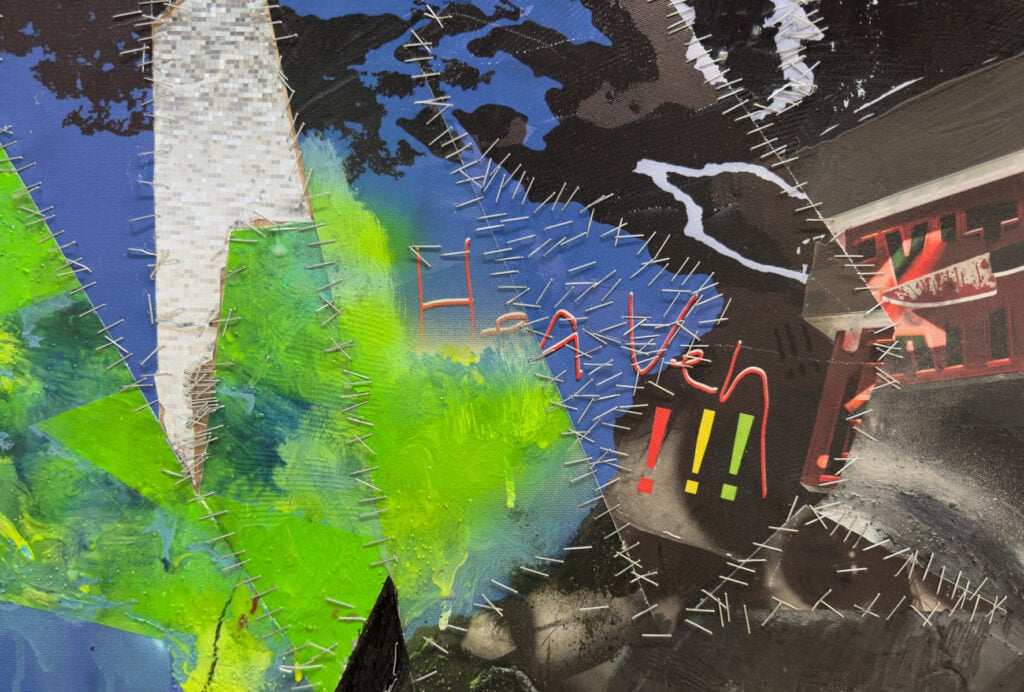
- This event has passed.
EVENT DESCRIPTION
PODIUM is proud to announce the gallery’s inaugural exhibition ‘Weirding Worlds’, a three-person presentation featuring paintings, sculptures, and video works by contemporary female artists Shuyi Cao, Anastasia Komar, and So Young Park. Taking Donna Haraway’s Chthulucene as the line of flight, the artists’ distinct yet intertwined aesthetical trajectories and boundary-defying use of media visualise the necessary third history beyond the mastery narratives of the Anthropocene and Capitalocene, challenging the linear progression and apocalyptic rhetoric inherent in Western-centric frameworks with imaginative, queer vocabularies and practices.
Seeking potential refuge that transcends the strictures of grand narratives, the exhibition invites the audience to turn to Donna Haraway’s idea of the Chthulucene to explore new ways of understanding ourselves as part of and becoming with the evolving planetary community. As the feminist scholar and historian of science and technology explains, one needs to first envision a worldview that calls for ‘ongoing multispecies stories and practices of becoming-with in times that remain at stake, in precarious times, in which the world is not finished and the sky has not fallen’, then may realise that ecological interdependence is to open up multiple possibilities of kinship for future becoming. Put differently, rather than reinforcing bondings that are rooted in ancestry and genealogy, it is to understand that all earthlings are kin on the level of matter and energy—after all, every sentient being shares a common flesh of molecules, atoms, and quantum particles. In a similar vein, Shuyi Cao’s multimedia sculptural installations and moving image work, Anastasia Komar’s biomorphic sculptural panels, and So Young Park’s sci-fi landscape paintings invite the audience to intensely interact, interplay, and collaborate with Earth-dwellers that represent voices of abjection and destabilising orders, where all can embrace and flourish in an ever-weirding climate.
Shuyi Cao’s newest works under the series The Other Writing (2024) are presented as fossilised fiction encrypted within the terrestrial matter that uncannily resembles miniature landscapes or alien meteorites. Comprised of aqua resin, aluminium, and debris of fauna, flora, and human activities spanning various timescales, the organically moulded forms, textures, and patterns stemming from actual geological surfaces represent the recording devices of the Earth as repositories for nonlinguistic inscription. Similarly, the mesmerising video work Begin with the End of What Comes Before (2024) merges microscopic imaging and hand-modelled digital animation, contemplating the deep transmutation between biologic and geologic matters through planetary evolution and human activities. Elsewhere, organically presented on industrial pedestals made of coarse light grey cement blocks, Cao’s hand-blown borosilicate glass works Intimacy of Strangers and glazed stoneware sculptures as they folded in and breached out represent a microcosm of queer kinships between networked life forms that transcend biological classifications and binaries, materialising a web of rhizomatic relations that ripples outwards boundlessly.
Anastasia Komar’s abstract paintings intertwined with glass or electroplated polymer sculptural structures are the outgrowth of her research in cutting-edge science, examining the uncanny intersection between art and contemporary bioengineering. With an enigmatic reptilian creature warping the wood panel in captivating silver-blue hues, Tuatara (2024), which means ‘peaks on the back’ or ‘spiny back’ in the Māori language, explores the eccentric body part and aboriginal connotations of this only surviving member of the order Sphenodontia, and how they symbolise a powerful, intuitive force imbued with ancestral and ancient wisdom. In lush turquoise hues and with dazzling hook-like formations, Siphonophorae (2024) studies the co-dependent nature of these highly polymorphic and complex creatures, while the kinships between these biological marvels inspire the viewer to ponder the definition of a static, finite entity and how collaborative works are crucial in worldmaking. Diatomea (2024), with its emerging and protruding glass polymer tentacles, continues to shed light on the essential roles of microorganisms in a planetary community. The iridescent painting Ascomycetes (2024), with a translucent sac fungus with spores draping on the surface, underlines how the ‘spore shooter’’s asexual or parasexual reproduction and its role as decomposers foster myriad kinship across terrains and species through the formative process and circulation of matter, unveiling how entities exist in mutual dependence and are composites of each other.
So Young Park’s lustrous paintings in glimmering violet and deep blue hues create a striking contrast with the sage green terrazzo tiles and harmonise with the stainless steel panels in the gallery space. In The way, where I am going (2024), waterfalls and glaciers are moulded into a foot and melt in mistful waters. Presented as the act of feet washing, the painting serves as an expression of humility, love, respect, reverence, and subservience, which encourages one to be submerged and baptised by the waters, as if the body will soon liquefy into molecules composed of hydrogen and oxygen. After the waves (2024) portrays the dreamscape of how the planet may transmute when territories are washed over by liquid metal-esque tides. With the terrain completely dissolved and abstracted into viscous fluid, and an obscure object hovering and approaching from afar, the work recalls the viewer’s abjected and traumatic memories from pre-symbolic times. Among Park’s smaller pictorial experiments, Deep sea (2024) and Remnant (2024) depict mystical creatures with strange tentacles and claws roaming in unknown realms with lilac and metallic waves and landscapes. Both beings seem to have orbs depicted as a black hole or burning red sun, they not only gaze at the viewer from within the canvas but also beam out the haunting queerness of such strange earthlings. Elsewhere, Laputa (2023), with its title referring to the 1986 Japanese animated fantasy adventure film written and directed by Hayao Miyazaki, surveys the deeply paradoxical and weirding nature of the planetary future.
Details
- Start:
- 23 March 2024
- End:
- 4 May 2024
- Event Category:
- Multimedia, Painting, Sculpture


